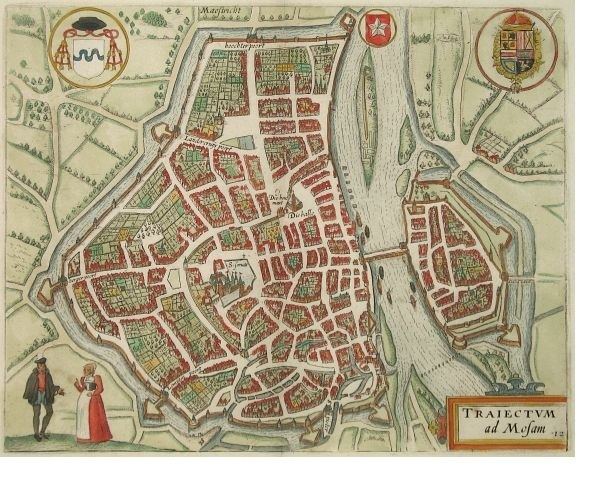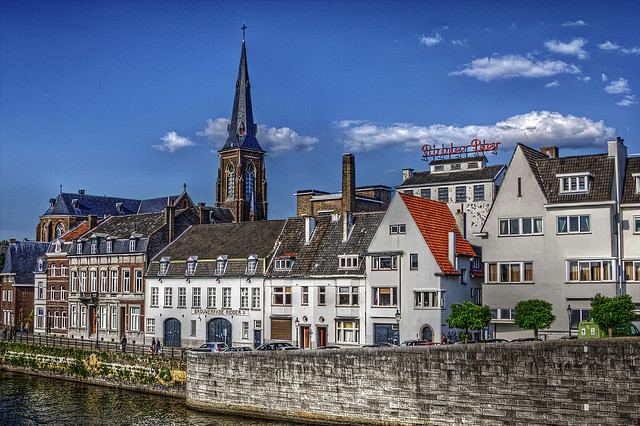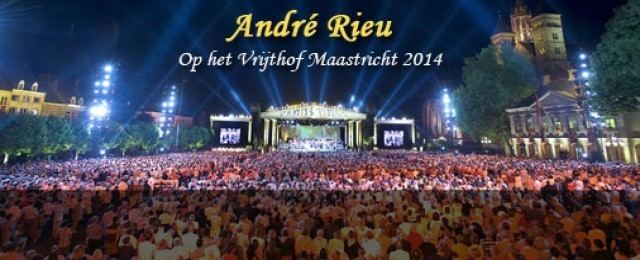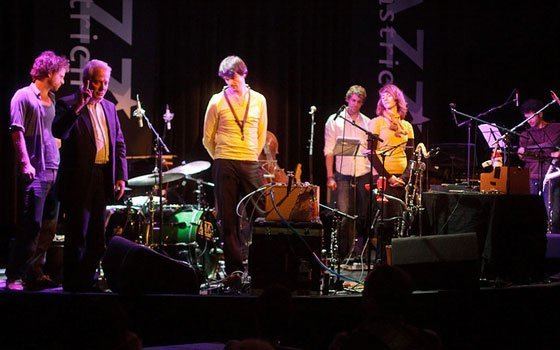Country Area 60.03 km2 Population 119,664 (2011) | ||
 | ||
Colleges and Universities Maastricht University, Maastricht Academy of Music, Maastricht Graduate School of Governance Points of interest Bonnefanten Museum, Basilica of Saint Servatius, Mount Saint Peter, Basilica of Our Lady - Maastricht, Museum aan het Vrijthof | ||
Map of Maastricht
Maastricht ([maːˈstrɪxt]; Limburgish : Mestreech [məˈstʀeˑx]; French: Maestricht ; Spanish: Mastrique ) is a city and a municipality in the southeast of the Netherlands. It is the capital and largest city of the province of Limburg, as well as the largest city in the historical duchy of Limburg, that today spans the Netherlands and Belgium.
Contents
- Map of Maastricht
- A fun week in maastricht with andre rieu
- Etymology
- Early history
- Middle Ages
- 16th to 19th centuries
- 20th century and onwards
- Neighbourhoods
- Neighbouring villages
- Climate
- Languages
- Religion
- Private companies based in Maastricht
- Public institutions
- Sights of Maastricht
- Museums in Maastricht
- Events and festivals
- Parks
- Natural areas
- Sports
- City council
- Aldermen and mayors
- Cannabis
- By car
- By train
- By tram
- By bus
- By air
- By boat
- Distances to other cities
- Secondary education
- Tertiary education
- Other
- Twin towns sister cities
- Other relations
- Born in Maastricht
- Residing in Maastricht
- Local anthem
- Andre rieu benny neyman ode to maastricht
- References

Maastricht is located on both sides of the Meuse river (Dutch: Maas), at the point where the Jeker River (French: Geer) joins it.

Maastricht developed from a Roman settlement to a Medieval religious centre, a garrison town and an early industrial city. Today, Maastricht is well-regarded as an thriving cultural and regional hub. Maastricht has 1677 national heritage sites (Rijksmonumenten), which is the second highest number for a Dutch town, after Amsterdam. It has become known, by way of the Maastricht Treaty, as the birthplace of the European Union, European citizenship, and the single European currency, the euro. The town is popular with tourists for shopping and recreation, and has a large growing international student population. Maastricht is a member of the Most Ancient European Towns Network and is part of the Meuse-Rhine Euroregion, which includes nearby German and Belgian cities Aachen, Eupen, Hasselt, Liège and Tongeren. The Meuse-Rhine Euroregion is a metropolis with a population of about 3.900.000 and counts various international universities.

A fun week in maastricht with andre rieu
Etymology

The name Maastricht is derived from Latin Traiectum ad Mosam (or Traiectum Mosae), meaning 'crossing at the Meuse', and referring to the bridge built by the Romans. The Latin name first appears in medieval documents and it is not known whether this was Maastricht's official name during Roman times. A resident of Maastricht is referred to as Maastrichtenaar whilst in the local dialect it is either Mestreechteneer or, colloquially, Sjeng (derived from the formerly popular French name Jean).
Early history
Neanderthal remains have been found to the west of Maastricht (Belvédère excavations). Of a later date are Palaeolithic remains, between 8,000 and 25,000 years old. Celts lived here around 500 BC, at a spot where the river Meuse was shallow and therefore easy to cross.
It is not known when the Romans arrived in Maastricht, or whether the settlement was founded by them. The Romans built a bridge over the Meuse in the 1st century AD, during the reign of Augustus Caesar. The bridge was an important link in the main road between Bavay and Cologne. Roman Maastricht was probably relatively small. Remains of the Roman road, the bridge, a religious shrine, a Roman bath, a granary, some houses and the 4th-century castrum walls and gates, have been excavated. Fragments of provincial Roman sculptures, as well as coins, jewelry, glass, pottery and other objects from Roman Maastricht are on display in the exhibition space of the city's public library (Centre Céramique).
According to legend, the Armenian-born Saint Servatius, Bishop of Tongeren, died in Maastricht in 384 and was buried there along the Roman road, outside the castrum. According to Gregory of Tours it was bishop Monulph who, around 570, built the first stone church on the grave of Servatius, the present-day Basilica of Saint Servatius. The city remained an early Christian diocese until it lost this position to nearby Liège in the early 8th century.
Middle Ages
In the early Middle Ages Maastricht was part of the heartland of the Carolingian Empire along with Aachen and the area around Liège. The town was an important centre for trade and manufacturing. Merovingian coins minted in Maastricht have been found in many places throughout Europe. In the 10th century Maastricht briefly became the capital of the duchy of Lower Lorraine.
During the 12th century the town flourished culturally. The provosts of the church of Saint Servatius held important positions in the Holy Roman Empire during this era. The city's two main churches were largely rebuilt and redecorated. Maastricht Romanesque stone sculpture is regarded as one of the highlights of Mosan art. Maastricht painters were praised by Wolfram von Eschenbach in his Parzival. Around the same time, the poet Henric van Veldeke wrote a legend of Saint Servatius, one of the earliest works in Dutch literature.
Shortly after 1200 the city received dual authority, with the prince-bishops of Liège and the dukes of Brabant holding joint sovereignty over the city. Maastricht received city rights in 1204. Soon afterwards the first ring of medieval walls were built. In 1275, the old Roman bridge collapsed under the weight of a large procession, killing 400 people; a replacement, the Sint Servaasbrug, was built to the north from 1280 to 1298, funded by church indulgences.
Throughout the Middle Ages, the city remained a centre for trade and manufacturing of wool and leather but gradually economic decline set in. After a brief period of economic prosperity in the 15th century, the city's economy suffered during the wars of religion of the 16th and 17th centuries, and recovery did not happen until the industrial revolution in the early 19th century.
16th to 19th centuries
The important strategic location of Maastricht resulted in the construction of an impressive array of fortifications around the city during this period. The Spanish and Dutch garrisons became an important factor in the city's economy. In 1579 the city was sacked by the Spanish army under general Alexander Farnese, Duke of Parma (Siege of Maastricht, 1579). For over fifty years the Spanish crown took over the role of the dukes of Brabant in the joint sovereignty over Maastricht. In 1632 the city was conquered by Prince Frederick Henry of Orange and the Dutch States General replaced the Spanish crown in the joint government of Maastricht.
Another Siege of Maastricht (1673) took place during the Franco-Dutch War. In June 1673, Louis XIV laid siege to the city because French battle supply lines were being threatened. During this siege, Vauban, the famous French military engineer, developed a new strategy in order to break down the strong fortifications surrounding Maastricht. His systematic approach remained the standard method of attacking fortresses until the 20th century. On 25 June 1673, while preparing to storm the city, captain-lieutenant Charles de Batz de Castelmore, also known as the comte d'Artagnan, was killed by a musket shot outside Tongerse Poort. This event was embellished in Alexandre Dumas' novel The Vicomte de Bragelonne, part of the D'Artagnan Romances. French troops occupied Maastricht from 1673 to 1678.
In 1748 the French again conquered the city at what is known as the Second French Siege of Maastricht, during the War of Austrian Succession. The French took the city for the last time in 1794, when the condominium was dissolved and Maastricht was annexed to the First French Empire (1794–1814). For twenty years Maastricht was the capital of the French département of Meuse-Inférieure.
After the Napoleonic era, Maastricht became part of the United Kingdom of the Netherlands in 1815. It was made the capital of the newly formed Province of Limburg (1815–1839). When the southern provinces of the newly formed kingdom seceded in 1830, the Dutch garrison in Maastricht remained loyal to the Dutch king, William I, even when most of the inhabitants of the town and the surrounding area sided with the Belgian revolutionaries. In 1831, arbitration by the Great Powers allocated the city to the Netherlands. However, neither the Dutch nor the Belgians agreed to this and the arrangement was not implemented until the 1839 Treaty of London. During this period of isolation Maastricht developed into an early industrial town.
Because of its eccentric location in the southeastern Netherlands, and its geographical and cultural proximity to Belgium and Germany, integration of Maastricht and Limburg into the Netherlands did not come about easily. Maastricht retained a distinctly non-Dutch appearance during much of the 19th century and it was not until the First World War that the city was forced to look northwards.
20th century and onwards
Early in World War II, the city was taken by the Germans during the Battle of Maastricht in May 1940. On 13 and 14 September 1944 it was the first Dutch city to be liberated by Allied forces. The three Meuse bridges were destroyed or severely damaged during the war. As elsewhere in the Netherlands, the majority of Maastricht Jews died in Nazi concentration camps.
During the latter half of the century, traditional industries (such as the famous Maastricht potteries) declined and the city shifted to a service economy. Maastricht University was founded in 1976. Several European institutions have found their base in Maastricht. In 1992, the Maastricht Treaty was negotiated and signed here, leading to the creation of the European Union and the euro.
In recent years, under mayor Gerd Leers, Maastricht launched a campaign against drug-related problems. Leers instigated a controversial plan to relocate some of the cannabis coffee shops—where the purchase of soft drugs in limited quantities is tolerated—from the city centre to the outskirts, in an attempt to stop foreign buyers from causing trouble in the downtown area. Although the so-called "coffee corner plan" has not been entirely abandoned, the new mayor Onno Hoes has given priority to the Dutch government's approach of limiting entrance to 'coffee shops' to Dutch adults only, and to tackle the problem of drug runners in cooperation with the city of Rotterdam (where the majority of drug runners are from).
Large parts of the city centre have been redeveloped, including the area around the main railway station, the main shopping streets, the Entre Deux and Mosae Forum shopping centres, and the Maasboulevard promenade along the Meuse. Also, a new quarter, including the new Bonnefanten Museum, a public library, a theatre and several housing blocks designed by international architects, was built on the grounds of the former Céramique potteries near the town centre. As a result, Maastricht looks notably smarter. Further large-scale projects, such as the redevelopment of the Sphinx and Belvédère areas, are underway.
Neighbourhoods
Maastricht consists of five districts and over 40 neighbourhoods. Each neighbourhood has a number which corresponds to its postal code.
- Maastricht Centrum (Binnenstad, Jekerkwartier, Kommelkwartier, Statenkwartier, Boschstraatkwartier, Sint Maartenspoort, Wyck-Céramique)
- South-West (Villapark, Jekerdal, Biesland, Campagne, Wolder, Sint Pieter)
- North-West (Brusselsepoort, Mariaberg, Belfort, Pottenberg, Malpertuis, Caberg, Malberg, Dousberg-Hazendans, Daalhof, Boschpoort, Bosscherveld, Frontenkwartier, Belvédère, Lanakerveld)
- North-East (Beatrixhaven, Borgharen, Itteren, Meerssenhoven, Wyckerpoort, Wittevrouwenveld, Nazareth, Limmel, Amby)
- South-East (Randwyck, Heugem, Heugemerveld, Scharn, Heer, De Heeg, Vroendaal)
The neighbourhoods of Itteren, Borgharen, Limmel, Amby, Heer, Heugem, Scharn, Oud-Caberg, Sint Pieter and Wolder all used to be separate municipalities or villages until they were annexed by the city of Maastricht in the course of the 20th century.
Neighbouring villages
The outlying areas of the following villages are bordering the municipality of Maastricht directly, which means among others that in many a case a considerable number of their inhabitants originate from Maastricht.
Clockwise from north to northwest:
("(B)" = Situated in Belgium)
Climate
Maastricht features the same climate as most of the Netherlands (Cfb, Oceanic climate), however, due to its more inland location in between hills, summers tend to be warmer (especially in the Meuse valley, which lies 70 metres lower than the meteorological station) and winters a bit colder, although the difference is only remarkable at a few days a year. The second highest temperature in the Netherlands, and the highest temperature of a still existing station was recorded on 2 July 2015 at 38.2 °C (100.8 °F).
Languages
Maastricht is a city of linguistic diversity, partly as a result of its location at the crossroads of multiple language areas and its international student population.
Religion
The largest religion in Maastricht is Christianity with 65,1% of the population that is Christian, of whom 92,31% is Catholic.
Private companies based in Maastricht
Public institutions
Since the 1980s a number of European and international institutions have made Maastricht their base. They provide an increasing number of employment opportunities for expats living in the Maastricht area.
Sights of Maastricht
Maastricht is known in the Netherlands and beyond for its lively squares, narrow streets, and historical buildings. The city has 1677 rijksmonumenten (national heritage sites), more than any Dutch city outside Amsterdam. The entire city centre is a protected cityscape ("beschermd stadsgezicht"). The tourist information office (VVV) is located in the Dinghuis, a medieval building overlooking Grote Staat. Maastricht's main sights include:
Museums in Maastricht
Events and festivals
Furthermore, the Maastricht Exposition and Congress Centre (MECC) hosts many events throughout the year.
Parks
There are several city parks and recreational areas in Maastricht:
Natural areas
Sports
City council
The municipal government of Maastricht consists of a city council, a mayor and a number of aldermen. The city council, a 39-member legislative body directly elected for four years, appoints the aldermen on the basis of a coalition agreement between two or more parties after each election. The 2006 municipal elections in the Netherlands were, as often, dominated by national politics and led to a shift from right to left throughout the country. In Maastricht, the traditional broad governing coalition of Christian Democrats (CDA), Labour (PvdA), Greens (GreenLeft) and Liberals (VVD) was replaced by a centre-left coalition of Labour, Christian Democrats and Greens. Two Labour aldermen were appointed, along with one Christian Democrat and one Green alderman. Due to internal disagreements, one of the VVD council members left the party in 2005 and formed a new liberal group in 2006 (Liberalen Maastricht). The other opposition parties in the current city council are the Socialist Party (SP), the Democrats (D66) and two local parties (Stadsbelangen Mestreech (SBM) and the Seniorenpartij).
Aldermen and mayors
The aldermen and the mayor make up the executive branch of the municipal government. After the popular previous mayor, Gerd Leers (CDA), decided to step down in January 2010 following the 'Bulgarian Villa' affair, an affair concerning a holiday villa project in Byala, Bulgaria, in which the mayor was alleged to have been involved in shady deals to raise the value of villas he had ownership of. Up until July 1, 2015 the mayor of Maastricht was Onno Hoes, a Liberal (VVD), the only male mayor in the country, who officially is married to a male person. In 2013 Hoes was the subject of some political commotion, after facts had been disclosed about intimate affairs with several other male persons. The affair had no consequences for his political career. Because of a new affair in 2014 Hoes eventually stepped down.
Since July 1, 2015 the current mayor of Maastricht has been Annemarie Penn-te Strake. Penn is independent and serves no political party, although her husband is a former chairman of the Maastricht Seniorenpartij. She has served for the Dutch judicial system for many years in many different positions. During her tenure as mayor she still serves as attorney general.
Cannabis
One controversial issue which has dominated Maastricht politics for many years and which has also affected national and international politics, is the city's approach to soft drugs. Under the pragmatic Dutch soft drug policy, a policy of non-enforcement, individuals may buy and use cannabis from 'coffeeshops' (cannabis bars) under certain conditions. Maastricht, like many other border towns, has seen a growing influx of 'drug tourists', mainly young people from Belgium, France and Germany, who provide a large amount of revenue for the coffeeshops (around 13) in the city centre. The city government, most notably ex-mayor Leers, have been actively promoting drug policy reform in order to deal with its negative side effects.
One of the proposals, known as the 'Coffee Corner Plan', proposed by then-mayor Leers and supported unanimously by the city council in 2008, was to relocate the coffeeshops from the city centre to the outskirts of the town (in some cases near the national Dutch-Belgian border). The purpose of this plan was to reduce the impact of drug tourism on the city centre, such as parking problems and the illegal sale of hard drugs in the vicinity of the coffeeshops, and to monitor the sale and use of cannabis more closely in areas away from the crowded city centre. The Coffee Corner Plan, however, has met with fierce opposition from neighbouring municipalities (some in Belgium) and from members of the Dutch and Belgian parliament. The plan has been the subject of various legal challenges and has not been carried out up to this date (2014).
On 16 December 2010, the Court of Justice of the European Union upheld a local Maastricht ban on the sale of cannabis to foreign tourists, restricting entrance to coffee shops to residents of Maastricht. The ban did not affect scientific or medical usage. In 2011, the Dutch government introduced a similar national system, the wietpas ("cannabis pass"), restricting access to Dutch coffeeshops to residents of the Netherlands. After protests from local mayors about the difficulty of implementing the issuing of wietpasses, Dutch parliament in 2012 agreed to replace the pass by any proof of residency. The new system has led to a slight reduction in drug tourism to cannabis shops in Maastricht but at the same time to an increase of drug dealing on the street.
By car
Maastricht is served by the A2 and A79 motorways. The city can be reached from Brussels and Cologne in approximately one hour and from Amsterdam in about two and a half hours.
The A2 motorway that runs through Maastricht in a double decked tunnel. Before 2016 the A2 motorway ran through the city and was heavily congested and caused air pollution in the urban area. Construction of a two-level tunnel designed to solve these problems started in 2011 and was opened (in stages) by December 2016.
In spite of several large underground car parks, parking in the city centre forms a major problem during weekends and bank holidays due to the large numbers of visitors. Parking fees are high in order to incite visitors to use public transport or park and ride facilities away from the centre.
By train
Maastricht is served by three rail operators, all of which call at the main Maastricht railway station near the centre and the smaller Maastricht Randwyck, located near the business and university district, and Maastricht Noord, which opened in 2013. Intercity trains northwards to Amsterdam, Eindhoven, Den Bosch and Utrecht are operated by Dutch Railways. The National Railway Company of Belgium runs south to Liège in Belgium. The line to Heerlen, Valkenburg and Kerkrade is operated by Arriva. The former railway to Aachen was closed down in the 1980s. The old westbound railway to Hasselt (Belgium) was restored in recent years and will be used as a modern tramline, scheduled to open in 2021.
By tram
The Dutch and Flanders governments have reached an agreement in 2014 to build a new tram route called Spartacus. It is scheduled to take three years, from 2015 to 2018, and cost €283 million. When it is completed, Spartacus will carry passengers from Maastricht city centre to Hasselt city centre, the capital of Flanders’ Limburg province, in 30 minutes. It will be operated by the transport company De Lijn, with 3 scheduled stops in Maastricht and further 10 in Flanders.
By bus
Regular bus lines connect the city centre, outer areas, business districts and railway stations. The regional Veolia bus network extends to most parts of South Limburg as well as to Hasselt, Tongeren, Maasmechelen and Liège in Belgium, and Aachen in Germany.
By air
Maastricht is served by the nearby Maastricht Aachen Airport (IATA: MST, ICAO: EHBK) – located in nearby Beek and informally referred to by that name – with regular scheduled flights to Alicante (on Ryanair) and Katowice (on Wizz Air), and seasonal and charter flights to other destinations. The airport is located about 10 kilometres (6 miles) north of Maastricht's centre.
By boat
Maastricht has a river port (Beatrixhaven) and is connected by water with Belgium and the rest of the Netherlands through the river Meuse, the Juliana Canal, the Albert Canal and the Zuid-Willemsvaart. Although there are no regular boat connections to other cities, various organized boat trips for tourists connect Maastricht with Belgium cities such as Liège.
Distances to other cities
These distances are as the crow flies and therefore not represent actual overland distances.
Secondary education
Tertiary education
Other
Twin towns — sister cities
Maastricht is twinned with:
Other relations
Born in Maastricht
Residing in Maastricht
Local anthem
In 2002 the municipal government officially adopted a local anthem (Limburgish (Maastrichtian variant): Mestreechs Volksleed, Dutch: Maastrichts Volkslied) composed of lyrics in Maastrichtian. The theme was originally written by Ciprian Porumbescu (1853–1883).
